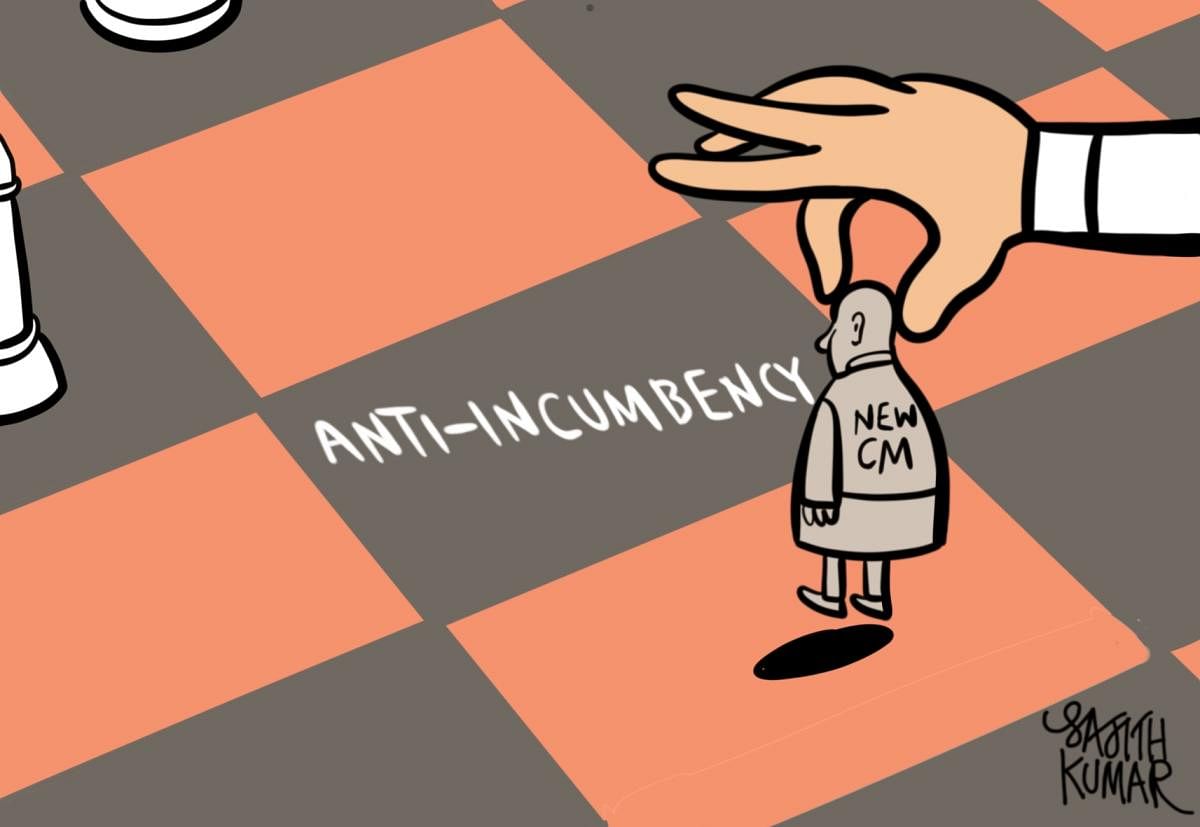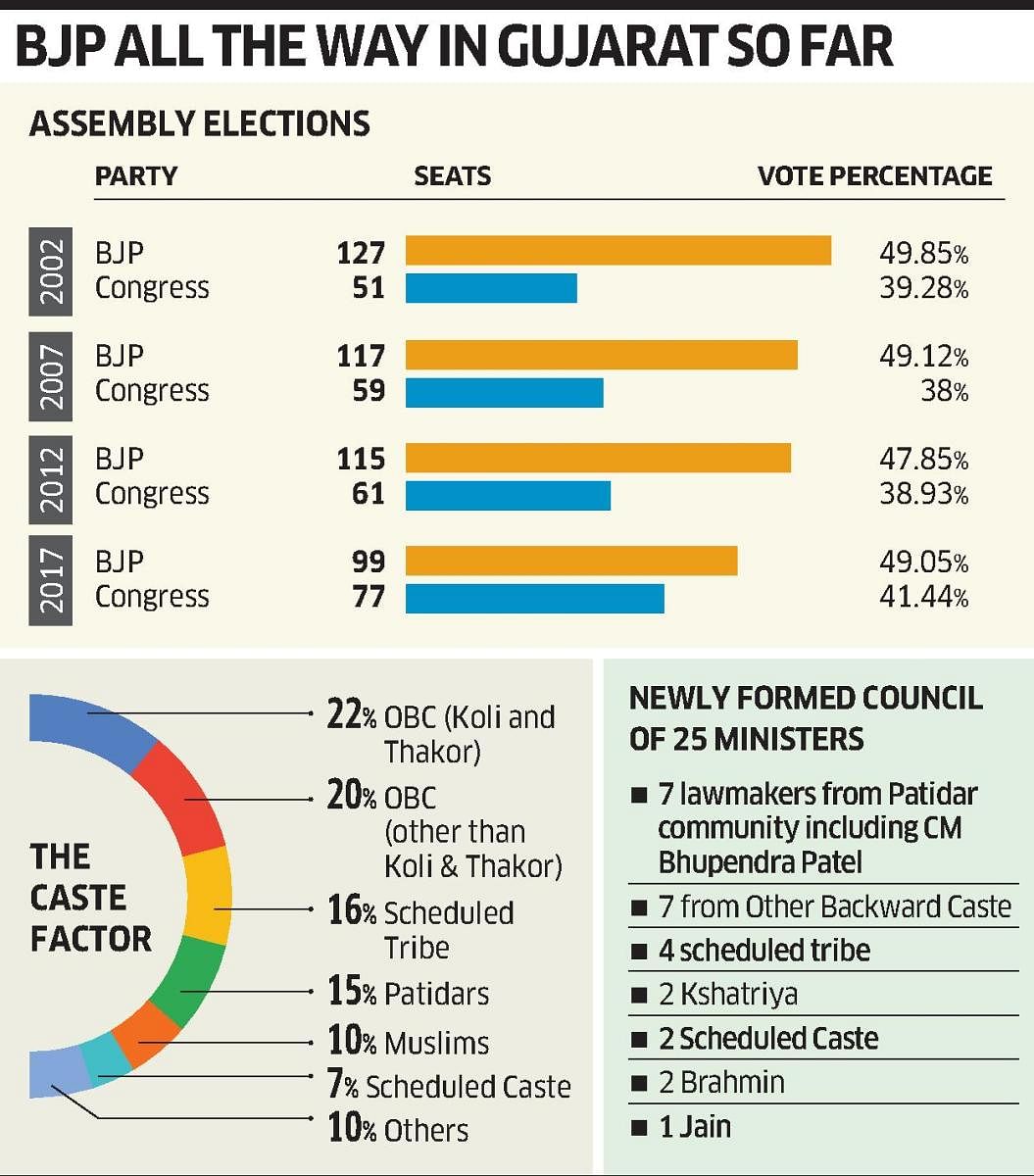

Gujarat is central to the rise and dominance of BJP in national politics. The party has sensed that a slide in its popularity chart could be inevitable, which it can’t afford. And therefore, it will do whatever it takes to retain power. On September 12, the BJP did something unthinkable in the home state of Prime Minister Modi and Union Home Minister Amit Shah – it asked its chief minister to resign.
The party removed all sitting ministers of the previous government and made 24 underlings, inexperienced MLAs as ministers including the chief minister. The party has termed its government’s “makeover” as an “abhinav prayog” or a new experiment for continuity. But the fact is that “uncertainty” in the BJP is writ large. The ground under its feet is shaking due to a deep anti-incumbency for being in power for 27 uninterrupted years. This experiment is nothing but a “gamble” to win the Assembly election to be held in the winter of 2022.
In 2016, BJP brought a caste neutral face as its chief minister in Vijay Rupani, from the minority yet influential Jain community. A year earlier, one of the most influential caste groups – Patidars - under the leadership of Hardik Patel, had tried to assert its power by demanding reservation in government jobs and educational institutes. The BJP looked the other way while Patidar youths, including Patel and his aides under the umbrella of Patidar Anamat Andolan Samiti, pitched for the opposition Congress along with one of the most popular Other Backward Caste leaders Alpesh Thakor and Dalit leader Jignesh Mevani. The result was a near defeat for the BJP in the 2017 Assembly polls. The ruling party was reduced to 99 seats, its worst winning tally.
Cut to September 11, 2021, nearly 14 months before the next Assembly polls, BJP sacked Rupani out of the blue and appointed a little known first time MLA Bhupendra Patel primarily for being a Patidar and former CM Anandiben Patel’s protege and days later sacked all experienced sitting ministers. The idea, BJP leaders say, is that the group of 25 all new ministers led by CM Patel will go to Assembly polls in December 2022 “unencumbered, free of the party’s previous leaders’ baggage.” The baggage includes “image of Rupani as a remote-controlled CM, gross mismanagement of covid-19 pandemic among others.”
Says a senior BJP leader: “There is uncertainty in the party for the 2022 polls. Amit Shah had picked up Rupani and he failed in 2017. So, it seems, Narendrabhai has given Anandiben a free hand and that’s why Bhupendra Patel has been elevated and so the Patidars are back in the game. Caste is what is going to be played out along with the face of the PM in the coming Assembly polls.”
“You can’t have further consolidation of Hindu votes, you can’t push development agenda beyond this as you can’t say Gujarat is backward. There is a saturation. So what do you do next? You desaturate them by adding or removing faces. It is basically a shot in the dark,” says a political observer.
To beat the anti-incumbency factor, the party has got back to caste politics in a big way to lure voters. Out of 25 ministers in the new cabinet, seven including the CM, are from the influential Patidar community, said to be core voters of the BJP. Seven ministers are from another dominant OBC community and four from scheduled tribes. The BJP has also given impetus to regions considered to be its stronghold but had drifted away to Congress or to the emerging Aam Aadmi Party over the years.
For example, a record seven ministers are MLAs from Saurashtra region, a traditionally BJP bastion. Earlier, the party had elevated three MPs from the region to the post of ministers in the Modi cabinet. Mansukh Mandaviya, Parshottam Rupala were made cabinet ministers in July. Dr Mahendrabhai Munjapara, also from Saurashtra,o became minister of state. Similarly, BJP has picked up four MLAs as ministers from Surat alone, said to be the first for a city to have so many representatives in one cabinet. Earlier, Surat MP Darshana Jardosh was also inducted into Modi’s cabinet as minister of state for railways and textiles.
While the BJP leaders are claiming that young and new ministers will be able to “energise” party workers, many party veterans are unhappy. “What the party has done is unheard of. How could you throw an entire cabinet into the dustbin? You can deny tickets to party leaders to avoid anti-incumbency but removing the entire ministers and replacing them with a bunch of inexperienced MLAs, 10 of them are not even matriculate, is a sign of autocracy,” says another party leader.
Teamless Congress
Congress had nearly defeated BJP in 2017 with the help of the trio - Hardik Patel, Alpesh Thakor and Jignesh Mevani - and won 77 seats and its allies had won three seats. Since then, however, Congress lost eight of its MLAs who switched to the BJP. Earlier this year, BJP decimated Congress in local body polls. BJP won all 31 district panchayats, 74 of 81 municipalities and 196 of 231 taluk panchayat seats. The result indicated that Congress had lost ground even in its stronghold of rural Gujarat.
For over two years, several posts in state committees have been filled due to infighting. State president and leader of opposition had resigned following the debacle in local body polls but even after six months, the party couldn’t replace them due to infighting. The party is divided into several factions and they are lobbying for these posts.
“We have a team and it is already reaching out to people. Party will decide on new appointments soon. We are going to the people, raising local issues such as large scale Covid-19 deaths due to mismanagement, farm distress, unemployment etc. We will fight the BJP’s caste politics with real issues concerning the people” said Congress spokesperson Manish Doshi.
For Congress, keeping its flock together is the biggest challenge. Shortly after the last election, it lost Alpesh Thakor to BJP, where he is now a spent force. Hardik Patel was elevated as a state working president, but he has not accepted in the party as yet, while efforts are on to bring Jignesh Mevani to the party fold. This will also be the first election for Congress in the last many decades minus the shadow of its master strategist Ahmed Patel, whom many also criticised in Congress for not letting other leaders grow in Gujarat even as he was hailed as key troubleshooter of Congress at the Centre. Patel passed away last year due to Covid-19 complications.
Resurging AAP
Unlike in 2014 when AAP first tried unsuccessfully to gain a foothold, Arvind Kejriwal’s party found a “foot in the door” earlier this year when it won 27 seats in Surat municipal election. In all, it won 41 seats in the local body polls. It was AAP’s first electoral success and since then, the party is considered to be a serious threat to both the BJP and the Congress. With a Patidar, Gopal Italia, at the helm as its state president, AAP is expected to upset the prospects of the two major political parties.
It was AAP campaign “Jan Samvedna” to reach out to Covid-19 affected families that forced Congress to take out its own campaign to sympathise with such families. In turn, the BJP also proceeded with its own campaign. In the recent past, it brought on board a news anchor, Isudan Gadhvi, and a prominent businessman in Surat, Mahesh Savani, from Patidar community, and a well-known farm activist Sagar Rabari.
With anti-incumbency naturally against the ruling BJP and Congress unprepared, AAP sees an opportunity. Time will tell whether Gujarat is on the cusp of a change or not.
Check out the latest DH videos: